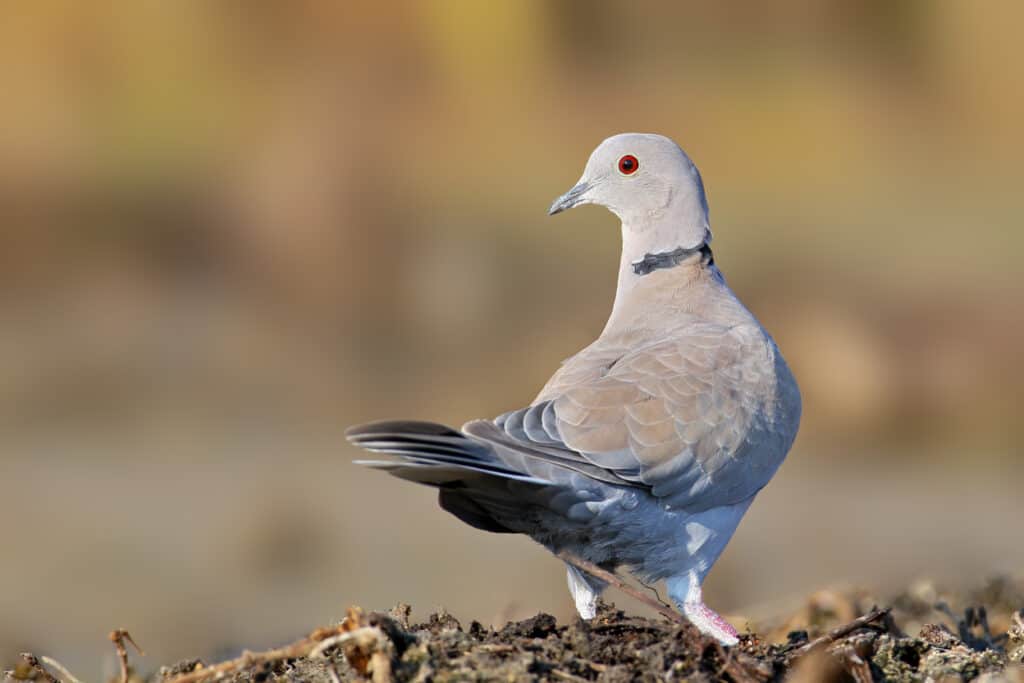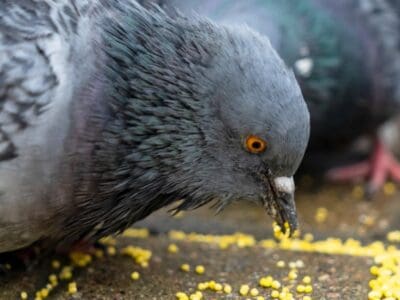Eurasian Collared Dove
Streptopelia decaocto
The Eurasian collared dove has been extensively studied due to its amazing ability to rapidly colonize new territories.
Advertisement
Eurasian Collared Dove Scientific Classification
- Kingdom
- Animalia
- Phylum
- Chordata
- Class
- Aves
- Order
- Columbiformes
- Family
- Columbidae
- Genus
- Streptopelia
- Scientific Name
- Streptopelia decaocto
Read our Complete Guide to Classification of Animals.
Eurasian Collared Dove Conservation Status
Eurasian Collared Dove Facts
- Name Of Young
- squabs or chicks
- Group Behavior
- Colonial Nesting
- Fun Fact
- The Eurasian collared dove has been extensively studied due to its amazing ability to rapidly colonize new territories.
- Estimated Population Size
- 60 - 110 million
- Biggest Threat
- Owls
- Most Distinctive Feature
- Black, crescent-shaped collar around the back of the neck
- Distinctive Feature
- Blunt, squared off tail, pinkish hue on head and breast
- Temperament
- Aggressve and territorial
- Wingspan
- 18 - 22 inches
- Incubation Period
- 14 - 19 days
- Age Of Independence
- 30 - 40 days
- Age Of Fledgling
- 18 days
- Habitat
- Agricultural, suburban or coastal areas
- Predators
- Owls, hawks, cats, crows
- Diet
- Herbivore
- Lifestyle
- Diurnal
- Colony
- Pair
- Favorite Food
- grains
- Common Name
- Eurasian collared dove
- Special Features
- Black, crescent-shaped collar around the back of the neck
- Origin
- Bulgaria
- Number Of Species
- 1
- Location
- Europe, Asia, North America, Central America, Northern Africa
- Average Clutch Size
- 2
- Nesting Location
- Platform nests at least 10 feet off the ground
- Age of Molting
- 4 weeks
Eurasian Collared Dove Physical Characteristics
- Color
- Grey
- Skin Type
- Feathers
- Lifespan
- Up to 17.8 years in the wild
- Weight
- 0.35 to 0.44 pounds
- Length
- 12 - 14 inches
- Age of Sexual Maturity
- Varies - Usually by the first spring
- Venomous
- No
- Aggression
- High
View all of the Eurasian Collared Dove images!
The Eurasian collared dove has been extensively studied due to its amazing ability to rapidly colonize new territories.
The Eurasian collared dove is considered an invasive species in much of its territory. With an estimated population of 100 million or more birds worldwide, and the ability to disperse hundreds of miles in each generation, this dove is an incredibly effective colonizer.
This collared dove, Streptopelia decaocto, is similar to several other doves with collars or rings on their necks. The European turtle dove, Streptopelia turtur, and the Barbary dove, Streptopelia risoria, are in the same genus.
The expansion of the Eurasian collared dove is concerning because it is an aggressive competitor and highly territorial. After being introduced in the Bahamas in 1970, the dove took up residence all over the Caribbean and throughout much of North America and Central America. As of 2020, it had made its way to the border of South America with no signs of stopping.
Incredible Eurasian Collared Dove Facts
- This dove spread from the Caribbean across most of the United States and into Canada in just a few short decades.
- The expansion of this species in Europe has been described as exponential.
- The name of the Eurasian collared dove’s genus means “collared dove” and includes several species, all with dark rings or collars on their necks.
- These doves are aggressive and territorial. They will attack other birds, ripping out feathers and pecking them viciously. They will even attack much larger crows in defense of their nests.
- Eurasian collared doves mate for life and work together to raise their young. Their offspring are driven by an urge to fly as far as possible before finding mates of their own.
- Mutations cause at least two variant colorations of the species: the Ino mutation results in a white to blond bird and a less common mutation causes brown plumage.
Where to Find Eurasian Collared Doves
The Eurasian collared dove originated in what is now Bulgaria. This dove was first described by the Hungarian naturalist, Irme Frivaldszky in 1838. It is not known how or when precisely the bird first arrived in the Balkans. It remained there for some time before beginning a rapid dispersal across Europe and Asia.
This determined dove made it all the way to Africa on its own. It now has populations in Morocco and Egypt and perhaps other countries in the northern portion of the continent.
The journey to North and Central America required a bit of human assistance. It began in 1970, when a pet supplier in the Bahamas imported a few breeding pairs from the Netherlands. In 1974 several of the birds were accidentally released during a robbery, and the supplier subsequently turned the rest of his stock loose. An estimated 50 or more Eurasian collared doves were then free and breeding in the Bahamas.
In an almost frightening display of expansion, the birds took only a few short years to spread from one island to another throughout the Caribbean. By the early 1980s, the doves had taken hold in Florida.
Today, the Eurasian collared dove has spread to dozens of countries, including those in Europe and Asia. Its range now covers most of the United States, into Canada, throughout the Caribbean and into Mexico. In 2020, the species was officially listed as present in Trinidad and Tobago. Researchers are watching carefully for the expansion of the species into South America from there.
Eurasian Collared Dove Scientific Name
The scientific name of the Eurasian collared dove is Streptopelia decaocto. The word “streptopelia” translates to “collared dove.” It is the name of the genus which includes Eurasian and other species of collared doves, including Streptopelia risoria, the Barbary dove, and Streptopelia turtur, the European turtle dove, among many others.
The name “decaocto” was given to the bird in reference to its call. The name is based on an ancient Greek myth about a young servant woman who called out the word in complaint about her poor wages. She was turned into a dove by Zeus so that she could escape her master.
Eurasian Collared Dove Appearance

This dove has a tail that distinguishes it from some similar species in that it is squared off rather than pointed.
©Voodison328/Shutterstock.com
The Eurasian collared dove, unsurprisingly, has a mark around its neck. In fact, it was named for the collar and belongs to a genus filled with species of doves with such markings.
The crescent-shaped black collar is rimmed in white, and it stands out against the light gray plumage of the bird. This gray is tinged with pink around the head and breast. The doves are about 12 to 14 inches long and weigh less than half a pound. Both the males and females look essentially the same.
This dove has a tail that distinguishes it from some similar species in that it is squared off rather than pointed. The underside of the tail is white. Adults have red eyes while juveniles have brown. Adults have a black beak and short, pinkish legs and feet. Juveniles look similar, with darker legs and just a bit of reddish color to their feathers. The juveniles also have a less defined collar until they mature.
Two known color aberrations exist within the Streptopelia decaocto species. One is the Ino mutation, which results in a white to blond color. This mutation is also present in Streptopelia risoria. Another rare mutation causes the Eurasian collared doves to exhibit brown plumage.
Eurasian Collared Dove Behavior
Perhaps the most defining characteristic of the Eurasian collared dove is the process by which the newly independent juveniles disperse from their parents. These birds are known to fly as far as 600 km, or nearly 375 miles, to start their adult lives. This urge to travel so far from their nest of origin is what drives the expansion of the species.
Much like a wildfire, the dispersal of the Eurasian collared dove follows a sort of jump and backfill pattern. Like smoldering embers, carried on the wind far ahead of a fire, so are the individual doves making their way as far from home as they can. New territories are claimed, far in advance of the existing population’s range, and the area in between quickly fills in as other members of the species take flight.
The Eurasian collared dove is an aggressive competitor wherever it goes. It will attack other birds and chase them from food sources. It has been observed pulling feathers from rival birds, jumping on their backs and pecking at them violently. The dove will even attack crows that try to pilfer eggs from its nest.
This dove tends to live close to humans, even nesting on buildings and other artificial structures. They are often found perched high in trees or on utility lines, and they roost together in large colonies.
Diet
Like many other doves, commercial bird feed is a favorite part of the Eurasian collared dove’s diet. Theyeat primarily grains in the wild, and they have adapted easily to eating from bird feeders.
These doves also tend to live near agricultural areas, feasting off the grain that is spilled or left in the fields. They will eat wild grains, berries and even small insects.
These doves can eat a large amount of food and store it in their crop. That means they are free to sit on a high perch and avoid predators while they take their time digesting what they have consumed.
Eurasian Collared Dove Reproduction
These doves reach sexual maturity around the first spring after they become independent. The exact age of the birds at that time can vary, because the Eurasian collared dove has multiple broods throughout the year.
The doves are monogamous and mate for life. Each of their broods is typically just 1 to 2 eggs, but they can have 3 to 6 broods each year. Both the male and the female take turns watching over the nest and incubating the eggs. Incubation takes about 14 to 19 days.
Although the Eurasian collared doves are attentive parents, their nests are not well formed. They are a simple pile of twigs, at least 10 feet off the ground, sometimes in trees or on artificial structures. Eggs and hatchlings often fall from the nests. This may be one reason the birds have so many broods each year.
After hatchlings emerge, the parents feed them with a white fluid they produce in their crops. This fluid is called crop milk. Within another 18 days, the offspring, known as either squabs or chicks, are ready to fledge. They are fully independent about 30 to 40 days after hatching, at which time they tend to disperse far from the nest and begin the cycle again.
Predators
The greatest predatory threats to Eurasian collared doves are owls, hawks and domestic cats. These doves feed on grains and are likely to be found around bird feeders put out by humans. They are most vulnerable when they come to the ground to feed.
Crows have been known to take eggs from the doves’ nests. Snakes would also be likely predators if the eggs were left unattended too long.
Eurasian collared doves have a few advantages that would help them to either avoid predators or challenge them. First, the pairs of doves mate for life and work together to incubate eggs. This means they are rarely unattended. The birds are also highly aggressive and territorial, and will defend their young even against much larger birds like crows. Finally, the adult doves can avoid exposure for long periods due to their efficient feeding habits, thus reducing the risk of being attacked.
Lifespan of the Eurasian Collared Dove
The longest recorded lifespan of a Eurasian collared dove in the wild is 17 years, 8 months. This specimen, a banded bird in Europe, was found dead. The longest living captive specimen lived around the same amount of time, 17 years, 9 months. The average life span is much shorter, with relatively few of these birds making it past about 5 or 6 years of age.
Concerns over the spread of Eurasian Collared Doves
One of the main concerns regarding the spread of these doves is that they may take up habitat and resources from native birds. Their aggressive nature gives them an advantage at feeders, and their willingness to fight can drive songbirds and even other doves away
Eurasian collared doves are listed as a species of least concern on the IUCN Red List. Their population is estimated at up to 75 million mature birds, and up to 100 million overall. The population is relatively stable in Europe, but is increasing at a rapid pace in other parts of the world, including across the United States.
Another concern is disease. Eurasian collared doves were recently recognized as carriers of West Nile Virus, a disease that can be deadly to humans.
They are also known to carry a parasite called Trichomonas gallinae, a protozoan that causes lesions in the mouth and sometimes the brain and liver of an infected bird. The resulting disease, trichomonosis, can cause a bird to lose weight and eventually die. Sanitation of bird feeders and water sources is necessary to help stop the spread of the disease.
Because Eurasian collared doves are not a protected species, they can be hunted in accordance with local laws. Extra care should be taken, though, to prevent shooting similar looking native birds which may be protected species.
Similar Animals
- Barbary dove – This dove, Streptopelia risoria, also known as the ringneck dove, originated in northern Africa.
- European turtle dove – This collared dove from Europe, Streptopelia turtur, was named for its call, not for turtles.
- Mourning dove – This North American dove, Zenaida macroura, is similar in size and color to the Eurasian collared dove, but does not have a collar.
Eurasian Collared Dove FAQs (Frequently Asked Questions)
What does the Eurasian collared dove look like?
The Eurasian collared dove is a light gray bird, about 12 to 14 inches in length, with a distinct black collar rimmed in white. It has a black beak, red eyes and pinkish legs and feet. Its tail is squared off and white on the underside.
How many varieties of Eurasian collared doves exist?
In addition to the standard gray Eurasian collared dove, there are two color aberrations. Both are caused by mutations in the bird’s DNA. The first is known as the Ino mutation, which results in a white to blond bird. The other, much less common mutation causes a brown coloration.
What makes the Eurasian collared dove special?
The Eurasian collared dove is one of the most efficient colonizers of the animal world. They have been studied extensively because of their rapid dispersal and expansion patterns.
Where did the Eurasian collared dove originate?
The Eurasian collared dove originated in what is now Bulgaria. It spread over the Balkans and remained there for quite some time before rapidly spreading across Europe, much of Asia and into Africa.
Where do Eurasian collared doves live?
Today, Eurasian collared doves can be found across much of North America, Central America, and the Caribbean in addiction to Europe, Asia and northern Africa. It was recorded just across the border from South America in 2020.
What do Eurasian collard doves eat?
Eurasian collared doves eat mostly grains. They are aggressive competitors at bird feeders, and they frequent agricultural areas where they can pick up spilled grain or remnants left in the fields. They will also eat wild grains, berries and insects.
How long do Eurasian collared doves live?
The longest recorded lifespan of a Eurasian collared dove in the wild is 17 years, 8 months. A specimen in captivity lived 17 years, 9 months. Most of these doves live around 5 or 6 years in the wild.
Are Eurasian collared doves rare?
Eurasian collared doves are not rare. They are a species of least concern on the IUCN Red List, with an estimated population of up to 100 million individuals and increasing.
Thank you for reading! Have some feedback for us? Contact the AZ Animals editorial team.
Sources
- American Birds / P. William Smith, Available here: https://sora.unm.edu/sites/default/files/journals/nab/v041n05/p01371-p01380.pdf
- The Red List / BirdLife International, Available here: https://www.iucnredlist.org/species/22727811/154457750#population
- NCBI, Available here: https://www.ncbi.nlm.nih.gov/Taxonomy/Browser/wwwtax.cgi?mode=Info&id=177147
- Texas Invasive Species Institute, Available here: http://www.tsusinvasives.org/home/database/streptopelia-decaocto
- BioOne / British Ornithologists' Club, Available here: https://bioone.org/journals/bulletin-of-the-british-ornithologists-club/volume-142/issue-2/bboc.v142i2.2022.a3/The-colourful-journey-of-the-Eurasian-Collared-Dove-Streptopelia-decaocto/10.25226/bboc.v142i2.2022.a3.full
- JSTOR / Journal of Field Ornithology Vol. 64, No. 4 / R. Hengeveld, Available here: https://www.jstor.org/stable/4513859
- Euring, Available here: https://euring.org/data-and-codes/longevity-list?page=3
- MSD Manual / Richard W. Gerhold, Jr., Available here: https://www.msdvetmanual.com/poultry/trichomonosis/trichomonosis


















